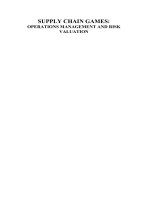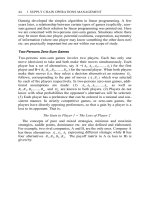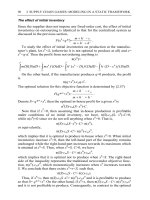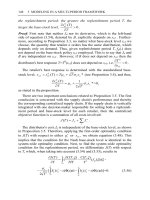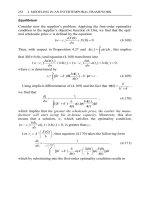Operations management heizer 6e ch16
Bạn đang xem bản rút gọn của tài liệu. Xem và tải ngay bản đầy đủ của tài liệu tại đây (503.65 KB, 56 trang )
Operations
Management
Chapter 16 –
Just-in-Time and
Lean Production Systems
PowerPoint presentation to accompany
Heizer/Render
Principles of Operations Management, 6e
Operations Management, 8e
© 2006
Prentice
Hall, Inc. Hall, Inc.
©
2006
Prentice
16 – 1
Outline
Global Company Profile: Green
Gear Cycling
Just-in-Time and Lean Production
Suppliers
Goals of JIT Partnerships
Concerns of Suppliers
© 2006 Prentice Hall, Inc.
16 – 2
Outline – Continued
JIT Layout
Distance Reduction
Increased Flexibility
Impact on Employees
Reduced Space and Inventory
© 2006 Prentice Hall, Inc.
16 – 3
Outline – Continued
Inventory
Reduce Variability
Reduce Inventory
Reduce Lot Sizes
Reduce Setup Costs
Scheduling
Level Schedules
Kanban
© 2006 Prentice Hall, Inc.
16 – 4
Outline – Continued
Quality
Employee Empowerment
Lean Production
Building a Lean Organization
5 S’s
Seven Wastes
JIT In Services
© 2006 Prentice Hall, Inc.
16 – 5
Learning Objectives
When you complete this chapter, you
should be able to:
Identify or Define:
Variability
Kanban
5 S System
Seven Wastes
© 2006 Prentice Hall, Inc.
16 – 6
Learning Objectives
When you complete this chapter, you
should be able to:
Describe or Explain:
Just-in-time (JIT) Philosophy
Pull Systems
Push Systems
The Goals of JIT Partnerships
Lean Production
Principles of Toyota Production System
© 2006 Prentice Hall, Inc.
16 – 7
Green Gear Cycling
Designs and manufactures high
performance travel bicycles (bike-in-asuitcase)
Strategy is mass customization with low
inventory, work cells, and elimination of
machine setups
Major focus on JIT and supply-chain
management
One day throughput time
Focus on quality
© 2006 Prentice Hall, Inc.
16 – 8
Just-In-Time and
Lean Production
JIT is a philosophy of continuous
and forced problem solving that
supports lean production
Lean production supplies the
customer with their exact wants
when the customer wants it without
waste
Key issues are continual
improvement and a pull system
© 2006 Prentice Hall, Inc.
16 – 9
Waste Reduction
Waste is anything that does not
add value from the customer point
of view
Storage, inspection, delay, waiting
in queues, and defective products
do not add value and are 100%
waste
© 2006 Prentice Hall, Inc.
16 – 10
Waste Reduction
Faster delivery, reduced work-inprocess, and faster throughput all
reduce waste
Reduced waste reduces room for
errors emphasizing quality
Reduced inventory releases assets
for other, productive purposes
© 2006 Prentice Hall, Inc.
16 – 11
Variability Reduction
JIT systems require managers to
reduce variability caused by both
internal and external factors
Variability is any deviation from the
optimum process
Inventory hides variability
Less variability results in less
waste
© 2006 Prentice Hall, Inc.
16 – 12
Causes of Variability
1. Employees, machines, and suppliers
produce units that do not conform to
standards, are late, or are not the
proper quantity
2. Engineering drawings or specifications
are inaccurate
3. Production personnel try to produce
before drawings or specifications are
complete
4. Customer demands are unknown
© 2006 Prentice Hall, Inc.
16 – 13
Pull Versus Push Systems
A pull system uses signals to
request production and delivery
from upstream stations
Upstream stations only produce
when signaled
System is used within the
immediate production process and
with suppliers
© 2006 Prentice Hall, Inc.
16 – 14
Pull Versus Push Systems
By pulling material in small lots,
inventory cushions are removed,
exposing problems and emphasizing
continual improvement
Manufacturing cycle time is reduced
Push systems dump orders on the
downstream stations regardless of
the need
© 2006 Prentice Hall, Inc.
16 – 15
JIT and Competitive
Advantage
JIT Requires:
Table 16.1
© 2006 Prentice Hall, Inc.
16 – 16
JIT and Competitive
Advantage
Which Results In:
Which Yields:
Table 16.1
© 2006 Prentice Hall, Inc.
16 – 17
Suppliers
JIT partnerships exist when a
supplier and purchaser work
together to remove waste and drive
down costs
Four goals of JIT partnerships are:
Elimination of unnecessary activities
Elimination of in-plant inventory
Elimination of in-transit inventory
Elimination of poor suppliers
© 2006 Prentice Hall, Inc.
16 – 18
JIT Partnerships
Suppliers
Few suppliers
Nearby suppliers
Repeat business with same suppliers
Support suppliers so they become or remain
price competitive
Competitive bidding mostly limited to new
purchases
Buyer resists vertical integration and subsequent
wipeout of supplier business
Suppliers encouraged to extend JIT buying to
their suppliers
Table 16.2
© 2006 Prentice Hall, Inc.
16 – 19
JIT Partnerships
Quantities
Share forecasts of demand
Frequent deliveries of small-lot quantities
Long-term contract
Minimal paperwork to release order (EDI or the
Internet)
Little or no permissible overage or underage
Suppliers package in exact quantities
Suppliers reduce production lot sizes
Table 16.2
© 2006 Prentice Hall, Inc.
16 – 20
JIT Partnerships
Quality
Minimal product specifications imposed on
supplier
Help suppliers meet quality requirements
Close relationships between buyers’ and
suppliers’ quality assurance people
Suppliers use poka-yoke and process control
charts
Table 16.2
© 2006 Prentice Hall, Inc.
16 – 21
JIT Partnerships
Shipping
Scheduling inbound freight
Gain control by using company-owned or
contract shipping and warehousing
Use of advanced shipping notice (ASN)
Table 16.2
© 2006 Prentice Hall, Inc.
16 – 22
JIT Layout
Reduce waste due to movement
Layout Tactics
Build work cells for families of products
Include a large number operations in a small area
Minimize distance
Design little space for inventory
Improve employee communication
Use poka-yoke devices
Build flexible or movable equipment
Cross train workers to add flexibility
Table 16.3
© 2006 Prentice Hall, Inc.
16 – 23
Distance Reduction
Large lots and long production
lines with single-purpose
machinery are being replaced by
smaller flexible cells
Often U-shaped for shorter paths
and improved communication
Often using group technology
concepts
© 2006 Prentice Hall, Inc.
16 – 24
Increased Flexibility
Cells designed to be rearranged
as volume or designs change
Applicable in office environments
as well as production settings
Facilitates both product and
process improvement
© 2006 Prentice Hall, Inc.
16 – 25




